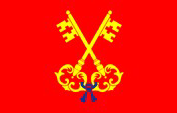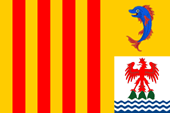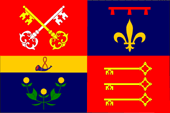Venaissin |
|
|
|
| Übersicht – Contents: | |
Diese Seite ist Teil des Projektes
Venaissin |
|
|
|
| Übersicht – Contents: | |
Flagge – Flag: |
|
 |
Flagge von Venaissin – flag of Venaissin – drapeau de Venaissin, Quelle/Source, nach/by: Die Welt der Flaggen |
| andere Flaggen – other Flags: | |
 |
seit/since 1999, Flagge der Region Provence-Alpes-Côte d’Azur – flag of Provence-Alpes-Côte d’Azur Region – drapeau de la région Provence-Alpes-Côte d’Azur, Quelle/Source, nach/by: Flags of the World |
 |
inoffizielle Flagge Département Vaucluse – unofficial flag of
Département Vaucluse – drapeau officieux de la Département Vaucluse Quelle/Source, nach/by: Wikipedia (FR) |
| Die
Flagge des Venaissin ist eine Wappen- flagge, sie gibt das Bild des Wappens wieder. |
The flag of Venaissin is a scutcheon-flag, its design is the image of the coat of arms. |
| Die damit verbundene Heraldik zeigt ein rotes Flaggentuch mit zwei gekreuzten goldenen Schlüsseln, die mit einem blauen Band verbunden sind. | The related Heraldry displays a red flag with two crossed golden keys, bound with a blue ribbon. |
| Seit 1999 wird in der Region "Provence-Alpes-Côte d’Azur" – zu das Venaissin gehört – eine inoffizielle Flagge verwendet, welche die Heraldik der Grafschaft Barcelona (die Provence gehörte 1112–1245 zur Grafschaft Barcelona), der Grafschaft Dauphiné und der Grafschaft Nizza kombiniert. | Since 1999 is in the region of "Provence- Alpes-Côte d’Azur" – to which the Venaissin belongs – an unofficial flag in use, which combines the features of the heraldry of the County of Barcelona (Provence belonged from 1112 to 1245 to the County of Barcelona), of the County of Dauphiné and of the County of Nice. |
| Im Département Vaucluse wird, wahrscheinl. inoffiziell, eine Flagge verwendet, welche die Merkmale der Heraldik des Venaissin enthält. | In the Département Vaucluse is – probably unofficially – a flag in use, which containes the features of the heraldry of Venaissin. |
| Nur sind nicht beide Schlüssel golden, sondern nur einer, und der andere ist silbern tingiert, so wie im Wappen des Vatikans. | However, there are not both keys are golden, but only one, and the other is tinged with silver, as in the coat of arms of the Vatican. |
| Quelle/Source: Volker Preuß, Wikipedia (D) | |
| Wappen – Coat of arms: | |
 |
14. Jhd./cent. bis/to 1791, Wappen der Grafschaft Venaissin – Coat of arms of the County of Venaissin – Blason du Comte de Venaissin, Quelle/Source, nach/by: Wikipedia (D) |
 |
Wappen von Avignon – Coat of arms of Avignon – Blason du Avignon, Quelle/Source, nach/by: Wikipedia (D) |
| Das Wappen des Venaissin zeigt ein rotes Schild mit zwei gekreuzten goldenen Schlüsseln, die mit einem blauen Band verbunden sind. Venaissin war zwischen 1274 und 1789 ein pästliche Grafschaft, also ein Besitz des Heiligen Stuhls, und Avignon war zwischen 1309 und 1377 sogar der Sitz des Papstes. So ist es kein Wunder, dass die pästliche Symbolik in Form der Schlüssel des Heiligen Petrus Aufnahme in das Wappen gefunden hat. Nur sind beide Schlüssel golden, und nicht wie beim Wappen des Vatikans einer davon silbern tingiert. | The coat
of arms of Venaissin shows a red shield with two crossed golden keys, bound
with a blue ribbon. Venaissin was a papal county between 1274 and 1789, a possession of the Holy See, and Avignon was even the seat of the Pope between 1309 and 1377. So it is no wonder that the papal symbolism in the form of the keys of Saint Peter has been included in the coat of arms. But both keys are golden and not one of them tinged in silver, as it is the case with the Vatican's coat of arms. |
| Quelle/Source: Wikipedia (D), heraldique.org | |
|
Die Regionen: Die historischen, französischen Regionen – The historical, french Regions |
|
|
in Schwarz: Provinz und Gouvernement im Jahre 1776, in Rot: ehemalige
Grafschaft, Provinz oder Gouvernement – in black: governorate and province in 1776, in red: former county, province oder governorate |
| Landkarte/Map: Volker Preuß |
| Erläuterungen zu den Regionen | Explanation about the Regions |
| Die bis zur Französischen Revolution bestehenden Provinzen (bzw. Gouvernements) waren historisch gewachsene Gebilde, die sich oft aus ehemaligen Lehensgebieten der französischen Krone, historischen Grafschaften und Herzogtümern heraus entwickelt hatten, oft über hunderte von Jahren bestanden und Regionalität (kulturelle Besonderheiten und regionale Sprachen) bewahrt hatten. Der Französischen Revolution waren solche Erscheinungen natürlich nicht erwünscht, und im Rahmen ihrer blutigen und gewalttätigen Gleichmacherei wurden jegliche regionale Bezüge ausgemerzt. Kurz nach der Revolution wurden die Provinzen aufgelöst und Frankreich in viele kleine Départements aufgeteilt, die annähernd gleich groß und den gleichen Status haben sollten. Benannt wurden die Départements nach Flüssen oder Gebirgen, um auf keinen Fall den Namen einer der alten Provinz zu verwenden. Es gelang jedoch nicht, die Verbindungen der Einwohner Frankreichs zu ihrer jeweiligen Region abzuschneiden, so dass im Jahre 1960 wieder administrative Regionen geschaffen wurden, um bestimmte Verwaltungsprozesse regional steuern zu können. Dazu wurden Départements, die in einer bestimmten historischen Provinz lagen, zu einer historisch oft gleichnamigen Region administrativ zusammengefasst. Die dabei entstandenen Gebilde decken sich nur annähernd mit den Grenzen der historischen Provinzen. Im streng zentralistischen Frankreich wird jedwede Regionalität vermieden, so dass auch die offiziellen Flaggen dieser Regionen meist aussehen wie Flaggen von Firmen, lieblos, unhistorisch, technokratisch und modernistisch, die hier nicht Gegenstand lexikalischer Betrachtungen sein sollen. Nur in wenigen dieser Regionen gibt es offizielle Flaggen die an historische Vorbilder erinnern. Aber, sogar die Existenz dieser heutigen Regionen ist in Frage gestellt, denn im Jahr 2014 wurde eine Gebietsreform beschlossen, welche die Anzahl der Regionen ab dem Jahr 2016 durch Fusionen auf fast die Hälfte verringert. Jedoch gibt es für fast alle Regionen inoffizielle Flaggen, die an die alten Provinzen und die alte Heraldik erinnern sollen. | The until
the French Revolution existing provinces (or governorates) have been
historically grown structures, which had their roots oftenly in former
fiefdoms of the French crown, historic counties and duchies. They oftenly
existed for hundreds of years and had preserved regionality (e.g. cultural
particularities and regional languages). On the occasion of the French
Revolution such phenomena were of course not desirable, and as part of their
bloody and violent egalitarianism any regional references were eliminated. Shortly after the French Revolution the provinces were dissolved and France became divided into many départements, which should have approximately the same size and the same status. The départements were named after rivers or mountains, to use never and in no circumstances the name of an old province. However, there was no success in cutting the connections of the people of France to their respective regions, so that administrative regions were re-created in 1960, to have a better control in regional administrative processes. In this way became départements, which were placed in a historical province, administratively grouped to an oftenly historically named region. The resulted structures coincide only approximately with the boundaries of the old provinces. In the strictly centralist France any regionality is avoided, so that even the official flags of these regions mostly look like flags of companies, unloving, unhistorical, technocratic and modernistic, and these flags should not be a subject of any lexical considerations here. Only in a few of that regions, exist official flags which remember the historical models. But, even the existence of these today's regions is douptful, because in 2014 was passed a territorial reform valid from the year 2016, that reduces the number of the existing regions by merging to nearly the half. However, there exist unofficial flags in nearly all of these regions, which should remember the old provinces and the old heraldry. |
|
Wikipedia-Link zu den Regionen Frankreichs:
hier klicken FOTW-Link zu den Regionen Frankreichs: hier klicken |
Wikipedia
Link to the regions of France:
click here FOTW Link to the regions of France: click here |
| Quelle/Source: Flags of the World, Wikipedia (D), Volker Preuß | |
|
Antike
· Besiedelung durch keltische Stämme, deren größter die Cavarer sind 58 v. Chr. · römische Eroberung, das Gebiet kommt an die Provinz Gallia Narbonensis 52 v. Chr. · ein Aufstand der Gallier unter Vercingetorix wird niedergeschlagen 4/5. Jahrhundert n. Chr. · die Burgunder wandern – aus der Region zwischen Oder und Weichsel kommend – in das Römische Reich ein, lassen sich am Mittelrhein bei Worms nieder und plündern benachbartes Römisches Siedlungsgebiet 436 · das Reich der Burgunder am Mittelrhein wird durch Hunnen in Römischem Dienst zerschlagen 443 · die überlebenden Burgunder werden von den Römern im Bereich des Genfer Sees und im heutigen Savoyen angesiedelt 443–500 · Herausbildung des Königreiches der Burgunder (Burgundia), Ausdehnung des Herrschaftsgebietes 534 · Eroberung des Königreiches der Burgunder durch die Franken, das heutige Burgund kommt an das Fränkische Reich, das Gebiet bleibt als Teilreich mit eigener Verwaltung bestehen 870 · durch die Teilung des Frankenreiches (Vertrag von Meersen) entsteht das Westfränkische Königreich, das Ostfränkische Königreich, und das Fränkische Königreich Italien – Burgund wird geteilt, der Norden (Hochburgund) kommt an das Westfränkische Reich, der Süden (Niederburgund) kommt an das Fränkische Königreich Italien 877 · Niederburgund trennt sich von Italien 879 · Boso von Vienne wird König von Niederburgund 880 · durch die Teilung des Frankenreiches (Verträge von Verdun und Ribbemont) entsteht das Westfränkische Königreich (das spätere Frankreich), das Ostfränkische Reich (das spätere Deutsche Reich), das Königreich Italien, das Königreich Hochburgund (unter dem Welfen Rudolf), das Königreich Niederburgund bleibt bestehen, ehemals burgundische Gebiete im Nordwesten kommen als "Regnum Burgundiae" ebenfalls an das Westfränkische Königreich 920–1016 · das Regnum Burgundiae entwickelt sich zu einem Herzogtum Frankreichs, das den Namen Burgund trägt (=> Herzogtum Burgund) 951 · Hochburgund und Niederburgund werden unter Konrad III. von Hochburgund zum Königreich Burgund vereinigt, das Land trägt auch den Namen Arelat, es werden diverse Grafschaften gebildet, darunter auch die Grafschaften Venaissin und Avignon 965–1019 · Herrschaft der Grafen der Provence, Arles und Avignon über die Grafschaft Venaissin mit der Hauptstadt Venasque 1019 · Emma von Provence, die Erbin von Provence, Arles und Avignon heiratet Wilhelm III. Graf von Toulouse, das Venaissin, kommt so an das Haus Toulouse 1033 · das Königreich Burgund (Arelat) kommt als Erbteil an das Deutsche Reich, der Römisch-Deutsche Kaiser Konrad der Ältere wird in Peterlingen (Payerne) zum König von Burgund gewählt, in den Folgejahren zerfällt das Land jedoch in mehrere Grafschaften (Grafschaft Provence, Grafschaft Venaissin, Grafschaft Savoyen, Grafschaft Dauphiné, Freigrafschaft Burgund), der letzte König von Burgund ist Kaiser Karl IV., der im Jahr 1365 inthronisiert wurde 1241 · Johanna von Toulouse, die Erbin von Toulouse, Provence, Arles und Avignon heiratet Alfons von Poitiers, den Bruder des Königs von Frankreich (Ludwig IX.), diese Gebiete und das Venaissin kommen so an die französische Krone 1274 · der König von Frankreich tritt das Venaissin an den Papst ab, das erst Jahre später (unter Papst Clemens V.) wieder zu einer Grafschaft erhoben wurde, einer Grafschaft des Kirchenstaats, der vor Ort durch einen päpstlichen Rector vertreten wird 1309 · Avignon wird Sitz des Papstes 1320 · Carpentras wird Hauptstadt von Venaissin 1348 · Papst Clemens VI. kauft von Gräfin Johanna von Provence die Stadt und Grafschaft Avignon, der vor Ort durch einen päpstlichen Vize-Legaten vertreten wird 1377 · der Sitz des Papstes wird wieder nach Rom verlegt 1663 · Einmarsch französischer Truppen 1668 · Einmarsch französischer Truppen 1768–1774 · Venaissin und Avignon sind von französischen Truppen besetzt 1789 · im Zuge der Französischen Revolution kommt es auch in Venaissin und Avignon zu Unruhen, Avignon fordert den Anschluss an Frankreich April 1790 · Ständeversammlung in Venaissin, das Staatswesen wird republikanisch reformiert, die Oberhoheit des Papstes wird jedoch bestätigt, der Vize-Legat von Avignon flieht nach Venaissin 14.09.1791 · in Folge eines Volksaufstandes und einer nicht autorisierten Volksabstimmung in beschließt die Französische Konstituierende Nationalversammlung die Vereinigung von Venaissin und Avignon mit Frankreich 19.09.1797 · Frieden von Tolentino, der Papst tritt Venaissin und Avignon unter Druck an Frankreich ab 1793 · Venaissin, Avignon und Orange werden zum Département Vaucluse zusammengefasst 1814/15 · Wiener Kongress, Neuordnung Europas nach der Ära Napoléon, der Kirchenstaat protestiert, weil die ehemals päpstlichen und von Napoléon abgepressten Gebiete Venaissin und Avignon auf dem Kongress nicht besprochen werden 1960 · Wiedereinführung von Regionen in Frankreich, das Departement Vaucluse kommt an die Region Provence-Alpes-Côte d’Azur |
|
antiquity
· settlement by Celtic tribes, the largest of them are the Cavarers 58 B.C. · Roman conquest, the area comes to the province of Gallia Narbonensis 52 B.C. · an uprising of the Gauls under Vercingetorix is suppressed 4th/5th century A.D. · the Burgundians come from the region between the Oder River and Vistula River and invade into the Roman Empire, settle on the Middle Rhine near Worms and plunder neighboring Roman settlement areas 436 · the Kingdom of Burgundy in the Middle Rhine area is shattered by Huns in Roman service 443 · the surviving Burgundians get settled by the Romans in the area of Lake Geneva and the today's Savoy 443–500 · establishing of the Kingdom of Burgundy (Burgundia), territorial expansions 534 · conquest of the Kingdom of Burgundy by the Franks, today's Burgundy comes to the Frankish Empire, the area will remain as part of empire with its own administration 870 · at the division of the Frankish Empire (Treaty of Meersen) arises the West Frankish Kingdom, the East Frankish Kingdom, and the Frankish Kingdom of Italy – Burgundy gets divided, the north (Upper Burgundy) comes to the West Frankish Kingdom, the south (Lower Burgundy) comes to the Frankish Kingdom of Italy 877 · Lower Burgundy separates from Italy 879 · Boso of Vienne is king of Lower Burgundy 880 · by the division of the Frankish Empire (Treaties of Verdun and Ribbemont) arises the West Frankish Kingdom (later France), the East Frankish Kingdom (later German Empire), the Kingdom of Italy, the Kingdom of Upper Burgundy (under Rudolf the Welf), the Kingdom of Lower Burgundy persists, and formerly Burgundian territories in the northwest come as "Regnum Burgundiae" to the West Frankish Kingdom too 920–1016 · Regnum Burgundiae develops to a duchy of France, which adopts the name of Burgundy (=> Duchy of Burgundy) 951 · Upper Burgundy and Lower Burgundy become united to the Kingdom of Burgundy, under Conrad III. of Upper Burgundy, this country is also called Arelat, there are several formed counties, including the counties of Venaissin and Avignon 965–1019 · rule of the Counts of Provence, Arles and Avignon over the county Venaissin with its capital Venasque 1019 · Emma of Provence, the heiress of Provence, Arles and Avignon gets married with William III. Count of Toulouse, the Venaissin comes thus to the house of Toulouse 1033 · the Kingdom of Burgundy (Arelat) comes as an inheritance to the German Empire, the Roman-German Emperor Conrad the Elder is elected in Peterlingen (Payerne) to the king of Burgundy, but in subsequent years, the country is divided into several counties (County of Provence, County of Venaissin, County of Savoy, County of Dauphiné, Franche-Comté), the last king of Burgundy is the Emperor Charles IV., who was enthroned in 1365 1241 · Joan of Toulouse, the heiress of Toulouse, Provence, Arles and Avignon marries Alfons of Poitiers, the brother of the king of France (Louis I .), these areas and the Venaissin come in this way to the french crown 1274 · the King of France cedes Venaissin to the Pope, which was not brought to a county until years later (under Pope Clement V.), a county of the Papal States, which is locally represented by a Papal Rector 1309 · Avignon is the seat of the Pope 1320 · Carpentras is the capital of Venaissin 1348 · Pope Clement VI. purchases from Countess Johanna of Provence the city and county of Avignon, which is now locally represented by a Papal Vice-Legate 1377 · the seat of the Pope will be moved back to Rome 1663 · invasion of French troops 1668 · invasion of French troops 1768–1774 · Venaissin and Avignon are occupied by French troops 1789 · during the French Revolution there are riots in Venaissin and Avignon too, Avignon calls the connection to France April 1790 · national estates assembly of Venaissin, the political system is reformed republican, but the supremacy of the Pope is confirmed, however, the Vice-Legate of Avignon flees to Venaissin 14th of September in 1791 · in consequence of a popular uprising and an unauthorized referendum the French Constituent National Assembly decides the affiliation of Venaissin and Avignon to France 19th of September in 1797 · Peace of Tolentino, the Pope cedes Venaissin and Avignon to France, under pressure 1793 · Venaissin , Avignon and Orange are merged to the Department of Vaucluse 1814/15 · Congress of Vienna, reorganization of Europe after the era of Napoleon, the Papal States protest because the former and by Napoléon extorted papal areas of Venaissin and Avignon were not discussed at the congress 1960 · reintroduction of regions in France, the Department of Vaucluse comes to the Region of Provence-Alpes- Côte d' Azur |
| Quelle/Source: Meyers Konversationslexikon, Wikipedia (D) |
| Der Name des "Venaissin" geht wahrscheinlich auf Venasque zurück, die alte Hauptstadt der Grafschaft. Der lateinische Name des Landes war Comitatus Vindascinus, der französische Comtat Venaissin. | The name "Venaissin" goes probably back to Venasque, the old capital of the county. The latin name of the country was Comitatus Vindascinus, the french name was Comtat Venaissin. |
| Quelle/Source: Wikipedia (D) | |